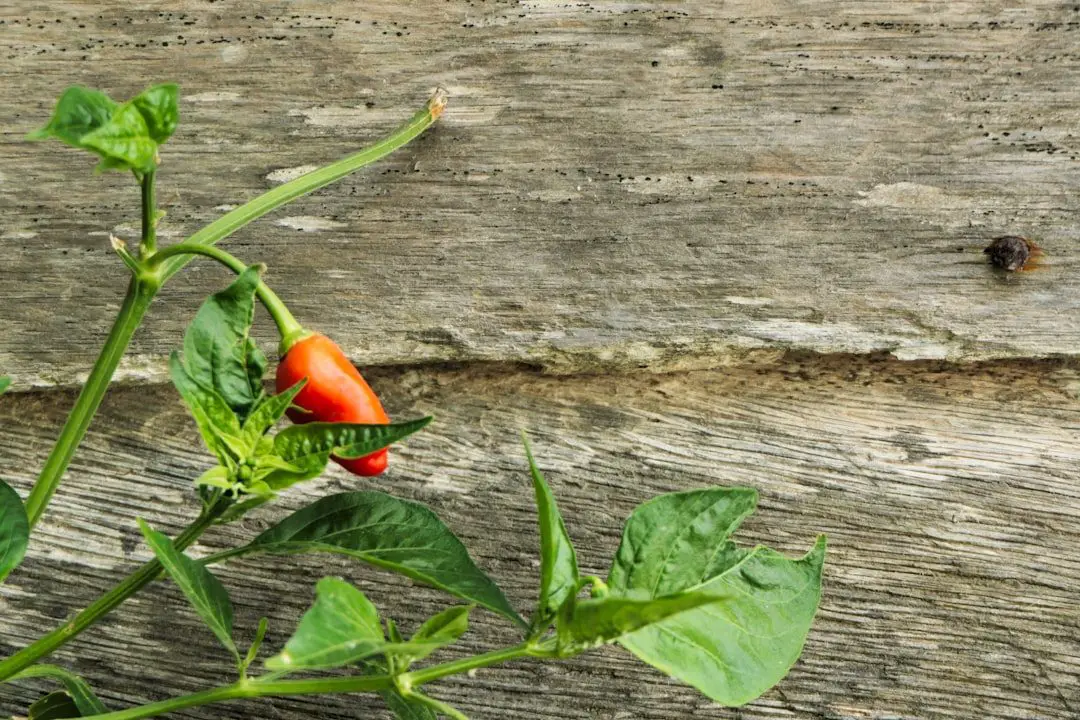
Habanero chili peppers are known for their intense heat and distinct flavor. These peppers have a long history, dating back thousands of years to the ancient Mayans and Aztecs. They are native to the Yucatan Peninsula in Mexico and were later introduced to other parts of the world through trade and exploration.
Habanero chili peppers are small, lantern-shaped peppers that come in a variety of colors, including orange, red, yellow, and even chocolate brown. They are one of the hottest peppers in the world, measuring between 100,000 and 350,000 Scoville Heat Units (SHU) on the Scoville scale. This makes them significantly hotter than jalapenos and even some varieties of ghost peppers.
Key Takeaways
- Habanero chili peppers are a popular type of chili pepper known for their intense heat and fruity flavor.
- The Scoville Scale is used to measure the heat of habanero chili peppers, which can range from 100,000 to 350,000 Scoville units.
- Habanero chili peppers are a nutritional powerhouse, containing high levels of vitamins A and C, as well as antioxidants and anti-inflammatory compounds.
- Habanero chili peppers can be used in a variety of culinary dishes, including salsas, marinades, and hot sauces.
- Growing habanero chili peppers requires warm temperatures, well-draining soil, and regular watering, and they can be stored in the freezer or dried for later use.
The Scoville Scale: Understanding the Heat of Habanero Chili Peppers
The Scoville scale is a measurement of the heat or spiciness of chili peppers. It was developed by pharmacist Wilbur Scoville in 1912 and is still widely used today. The scale measures the concentration of capsaicin, the compound responsible for the heat in chili peppers.
Habanero chili peppers rank high on the Scoville scale, with a range of 100,000 to 350,000 SHU. To put this into perspective, jalapenos typically measure between 2,500 and 8,000 SHU, while ghost peppers can reach up to 1 million SHU.
The heat of habanero chili peppers can vary depending on factors such as growing conditions, ripeness, and even individual plants within the same variety. The heat is concentrated in the seeds and ribs of the pepper, so removing these can help reduce the spiciness.
Health Benefits of Habanero Chili Peppers: A Nutritional Powerhouse
Habanero chili peppers are not only hot, but they are also packed with nutrients. They are a good source of vitamins A and C, as well as potassium and dietary fiber. These peppers also contain capsaicin, which has been shown to have numerous health benefits.
Consuming habanero chili peppers can help boost metabolism and aid in weight loss. Capsaicin has been found to increase thermogenesis, or the production of heat in the body, which can lead to increased calorie burning. It may also help reduce appetite and increase feelings of fullness.
Research has also shown that capsaicin can have anti-inflammatory and pain-relieving effects. It may help reduce symptoms of arthritis and other inflammatory conditions. Additionally, capsaicin has been found to have antimicrobial properties, which can help fight off infections.
Culinary Uses of Habanero Chili Peppers: Adding Heat to Your Dishes
| Culinary Uses of Habanero Chili Peppers | Benefits |
|---|---|
| Adding Heat to Your Dishes | Enhances flavor and adds a spicy kick to any dish |
| Spicy Sauces and Marinades | Can be used to make hot sauces, marinades, and dressings |
| Meat and Seafood Dishes | Great for adding flavor to grilled meats and seafood dishes |
| Salsas and Dips | Can be used to make spicy salsas and dips for chips and vegetables |
| Vegetarian and Vegan Dishes | Can be used to add flavor and heat to vegetarian and vegan dishes |
Habanero chili peppers are a staple in many cuisines around the world, particularly in Latin American and Caribbean dishes. They add a fiery kick to salsas, sauces, marinades, and soups. Habaneros can also be used to make hot sauces and spice rubs.
When cooking with habanero chili peppers, it’s important to handle them with care. The oils from the peppers can cause skin irritation and burns, so wearing gloves is recommended. It’s also a good idea to remove the seeds and ribs if you prefer a milder flavor.
Habanero chili peppers pair well with ingredients such as citrus fruits, tropical fruits like mango and pineapple, and creamy dairy products like cheese and yogurt. The sweetness of these ingredients helps balance out the heat of the peppers.
Growing Habanero Chili Peppers: Tips for a Bountiful Harvest
If you’re interested in growing your own habanero chili peppers, there are a few things to keep in mind. These peppers thrive in warm climates and require a long growing season, so they are best suited for regions with hot summers.
Habanero chili peppers can be grown from seeds or seedlings. They prefer well-drained soil and should be watered regularly, but not overwatered. It’s important to provide them with plenty of sunlight, at least six hours a day.
Common pests that can affect habanero chili peppers include aphids, spider mites, and whiteflies. These can be controlled with insecticidal soap or by introducing beneficial insects like ladybugs. Diseases such as powdery mildew and bacterial spot can also affect habanero chili peppers, so it’s important to monitor the plants and take appropriate measures if necessary.
How to Store Habanero Chili Peppers: Keeping Them Fresh and Flavorful

To keep habanero chili peppers fresh and flavorful, it’s important to store them properly. If you have harvested your own peppers, they should be stored in a cool, dry place away from direct sunlight. They can be kept at room temperature for up to a week.
If you have more habanero chili peppers than you can use within a week, they can be frozen or dried for long-term storage. To freeze habaneros, simply wash and dry them, then place them in a freezer bag or container. They can be stored in the freezer for up to six months.
To dry habanero chili peppers, you can either air dry them or use a dehydrator. Air drying can take several weeks, while using a dehydrator can speed up the process to a few hours. Once the peppers are completely dry, they can be stored in an airtight container for up to a year.
The History of Habanero Chili Peppers: From the Mayans to Modern Times
Habanero chili peppers have a rich history that dates back thousands of years. They were first cultivated by the ancient Mayans and Aztecs in what is now Mexico. These civilizations used habaneros not only for culinary purposes but also for medicinal and religious purposes.
The Mayans believed that habanero chili peppers had mystical and spiritual properties. They used them in rituals and ceremonies, as well as for medicinal purposes. The Aztecs also valued habaneros for their heat and flavor, using them in a variety of dishes.
Habanero chili peppers were later introduced to other parts of the world through trade and exploration. They became popular in the Caribbean, where they are still a key ingredient in many traditional dishes. Today, habanero chili peppers are enjoyed by people all over the world for their unique flavor and intense heat.
Exploring Different Varieties of Habanero Chili Peppers: Beyond the Classic Orange
While the classic orange habanero chili pepper is the most well-known variety, there are actually many different types of habaneros to explore. These include red, yellow, and even chocolate brown varieties. Each variety has its own unique flavor profile and heat level.
Red habanero chili peppers are slightly sweeter than their orange counterparts and have a slightly lower heat level. Yellow habaneros have a fruity flavor with a hint of citrus and are slightly milder than orange habaneros. Chocolate habaneros have a rich, smoky flavor and are known for their deep brown color.
In addition to these color variations, there are also lesser-known varieties of habanero chili peppers that are worth exploring. For example, the Scotch Bonnet pepper is often considered a type of habanero due to its similar heat level and flavor profile. It is commonly used in Caribbean cuisine.
Using Habanero Chili Peppers in Cocktails: Spicing Up Your Drinks
Habanero chili peppers can also be used to add a spicy kick to cocktails. Their heat and flavor can complement a variety of spirits, from tequila and mezcal to vodka and rum. Here are a few popular cocktails that incorporate habanero chili peppers:
– Spicy Margarita: Combine tequila, lime juice, orange liqueur, and a muddled habanero pepper for a fiery twist on the classic margarita.
– Habanero Mojito: Muddle fresh mint leaves, lime juice, simple syrup, and a sliced habanero pepper. Add rum and club soda for a refreshing and spicy mojito.
– Spicy Bloody Mary: Add a few slices of habanero pepper to your favorite Bloody Mary recipe for an extra kick of heat.
– Habanero Martini: Infuse vodka with sliced habanero peppers for a few days, then strain and use the infused vodka to make a spicy martini.
When using habanero chili peppers in cocktails, it’s important to start with a small amount and adjust to taste. The heat can vary depending on the peppers, so it’s best to err on the side of caution and add more if desired.
Safety Tips for Handling Habanero Chili Peppers: Avoiding Burns and Irritation
Habanero chili peppers are known for their intense heat, but they can also cause skin irritation and burns if not handled properly. Here are some safety tips to keep in mind when working with habaneros:
– Wear gloves: To protect your hands from the oils in the peppers, it’s recommended to wear gloves when handling habaneros. This will help prevent skin irritation and burns.
– Avoid touching your face: Be careful not to touch your face or eyes while handling habaneros. The oils can cause irritation and burning sensations.
– Wash your hands thoroughly: After handling habaneros, wash your hands thoroughly with soap and water. This will help remove any lingering oils and prevent accidental contact with sensitive areas.
– Use caution when cutting: When cutting habaneros, be careful not to touch your face or eyes with the knife or cutting board. It’s also a good idea to use a separate cutting board for peppers to avoid cross-contamination.
– Seek medical attention if necessary: If you experience severe burning or irritation from habanero peppers, seek medical attention. In some cases, the oils can cause more serious reactions that may require treatment.
Habanero chili peppers are a fiery and flavorful ingredient that can add a kick to any dish or cocktail. They have a long history and are enjoyed by people all over the world for their unique flavor and intense heat. From their nutritional benefits to their culinary uses, habanero chili peppers offer a range of possibilities for those who are willing to embrace the heat. So why not give them a try in your next recipe or cocktail? You might just discover a new favorite ingredient.
If you’re a fan of spicy food, you’ll love this article on Flavorful Sips about habanero chili peppers. These fiery peppers are known for their intense heat and unique flavor. Whether you’re looking to add a kick to your favorite dishes or want to explore new recipes, habanero chili peppers are a must-try ingredient. Check out this article for tips on how to use habanero chili peppers in your cooking and discover delicious recipes that showcase their bold flavor. And while you’re at it, don’t forget to explore the other interesting articles on Flavorful Sips, such as their easy cheesecake recipe guide, a guide to making rogan josh spice blend, and the best organic soft drinks for a healthy lifestyle.



